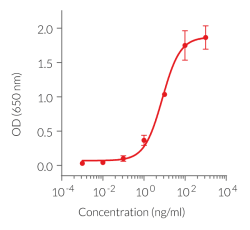Pam3CSK4 Biotin
-
Cat.code:
tlrl-bpms
- Documents
ABOUT
Biotinylated synthetic triacylated lipopeptide
Pam3CSK4 is a synthetic triacylated lipopeptide (LP) that mimics the acylated amino terminus of bacterial LPs.
Pam3CSK4 is a potent activator of the proinflammatory transcription factor NF-κB.
Activation is mediated by the interaction between TLR2 and TLR1 which recognize LPs with three fatty acids, a structural characteristic of bacterial LPs.
All products are for internal research use only, and not for human or veterinary use.
SPECIFICATIONS
Specifications
C103H192N14O17S2 •2 TFA
10 - 300 ng/ml
Cellular assays
Each lot is functionally tested and validated.
CONTENTS
Contents
-
Product:Pam3CSK4 Biotin
-
Cat code:tlrl-bpms
-
Quantity:50 µg
1.5 ml endotoxin-free water
Shipping & Storage
- Shipping method: Room temperature
- -20°C
- Avoid repeated freeze-thaw cycles
- Protect from light
Storage:
Caution:
DOCUMENTS
Documents
Technical Data Sheet
Safety Data Sheet
Certificate of analysis
Need a CoA ?




